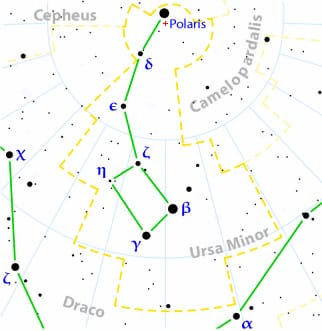Have you ever seen small dipper or Ursa minor in the clear night sky if not you must have heard about it? It is a constellation that consists of seven stars including the pole star or north star.
Ursa minor or little bear is a constellation beside the Ursa major which can be seen from the latitude of +90 to -10 degrees and lies in the third quadrant of the northern sky. It comprises of seven major stars. The four stars make the ladle structure while the other stars make the handle. It is known that little dipper was one of the 48 constellations discovered by the Greek astronomer and mathematician Ptolemy and now is one of the 88 constellations that mankind knows. The Ursa minor is helping many sailors, travelers, and lost people for ages to navigate them because of the pole star present at the tip of its tail. It is the brightest star in the constellation. If you are standing at the north pole then the Polaris will be right above your head.
 |
| Ursa Major in the night sky |
It is interesting to note that after 14,000 years Polaris will not be the north star due to the fact that the north celestial pole shifts its axis over the course of 26,000 years and the vega star in the constellation of the Lyra will be called as the north star and the cycles repeats.
 |
| Representation of Ursa Major and Ursa Minor |
The Ursa minor is the 56th largest constellation in the northern hemisphere sky with the area occupying 256 square degrees. Stars that make up the constellation are Polaris(Alpha Ursa Minories), Kochab(Beta Ursa Minoris), Pherkad(Gamma Ursa Minoris), Anwar al Farkadain(Eta Ursa Minoris), Akhfa al Farkadain (Zeta Ursa Mtinoris), Yildun(Delta Ursa Minoris).
 |
| Stars that make the Ursa Minor |
Myths:
The most common myth we hear about Ursa minor comes from greek mythology. Zeus a Greek god with a great passionate love for mortal women. The story starts from Artemis, moon goddess ran a society of nymphs who sworn vows of chastity and the finest of those nymphs was Callisto whose beauty attracted the hunger of love of the Zeus, he approached the Callisto as the Apollo the brother of the Artemis and made her fall in love with him. He frequently visited the earth and days passed, they grew as the passionate lovers, they both had a son named Arcas this asked the attention of Zeus's cruel wife, Hera. Out of the fear of his wife, Zeus made Callisto a bear and she had to roam in the wild alone. She spent 15 years alone as she was unable to be friends with other animals because she still had human feelings. One day she saw her son as a brave young man and she ran towards him out of love forgetting that she is a bear, Arcas thought the bear is attacking him so he threw a spear towards her. Zeus intervened in the matter and made Arcas bear too and set them in heaven as constellations, away from the sight of his wife.
Similar story we found in the mythology of Romans but instead of Zeus there was Jupiter and in place of Hera there was Juno. This tale is famous among the Romans but with a slight difference
when Callisto gave birth to Arcas so out of jealousy, Juno makes Callisto bear and make her wander the forest for the rest of her life and when Callisto see her child she ran towards him, unaware of the fact that the bear is his mother she throws spear toward her Jupiter stops the spear and to save them further damage Jupiter make Arcas baby bear and swung thyme into heavens so they can live peacefully among the stars.
In an older myth, the seven major stars that make up the Ursa minor or little dipper are in fact the seven daughters of Atlas who wanted to acquire Hera's orchard a golden tree of immortality giving apples grew.
In an older myth, the seven major stars that make up the Ursa minor or little dipper are in fact the seven daughters of Atlas who wanted to acquire Hera's orchard a golden tree of immortality giving apples grew.
Comments
Post a Comment